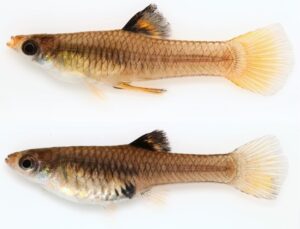Livebearing fishes from the family Poeciliidae provide a unique model system to study genital evolution. Male Livebearers internally inseminate females, transferring sperm via a modified anal fin (gonopodium). The gonopodium differs among each of the ~275 species in the family.
Gonopodial function
Some gonopodia have simple rod-like structures while others have hooks, barbs, and sensory papillae. Why these variations exists and how they contribute to gonopodial function remain important questions. One of the goals of our research is to determine the function of structures such as hooks, barbs, and palps. What role do they play in copulation? Are they associated with other copulatory traits such as behavior? And does the local environment play a role in their utility? We employ both lab and field experimental techniques to address these questions.
Genital asymmetry
 In most livebearing fish species, the gonopodium is bilaterally symmetrical. However, in some, it is asymmetrical, deviating in either a dextral (right-handed) or sinistral (left-handed) form. Several genera of livebearers, such as Carlhubbsia, Phallichthys, and Poeciliopsis, express directional asymmetry in their gonopodium, which means that all males express a similar dextral or sinistral asymmetry. In contrast, in the genus Xenophallus, there are both dextral and sinistral male forms coexisting in the same populations. This asymmetry is expressed as a dextral or sinistral twist at the distal tip of the gonopodium, presumably the place where sperm is transferred to the female gonopore. One focus of our research is to better understand these asymmetries. Why do they evolve? What causes them? What is their function? And how are polymorphisms maintained within species? We tackle these sorts of questions using experimental, genetic, and field approaches in search of answers.
In most livebearing fish species, the gonopodium is bilaterally symmetrical. However, in some, it is asymmetrical, deviating in either a dextral (right-handed) or sinistral (left-handed) form. Several genera of livebearers, such as Carlhubbsia, Phallichthys, and Poeciliopsis, express directional asymmetry in their gonopodium, which means that all males express a similar dextral or sinistral asymmetry. In contrast, in the genus Xenophallus, there are both dextral and sinistral male forms coexisting in the same populations. This asymmetry is expressed as a dextral or sinistral twist at the distal tip of the gonopodium, presumably the place where sperm is transferred to the female gonopore. One focus of our research is to better understand these asymmetries. Why do they evolve? What causes them? What is their function? And how are polymorphisms maintained within species? We tackle these sorts of questions using experimental, genetic, and field approaches in search of answers.

